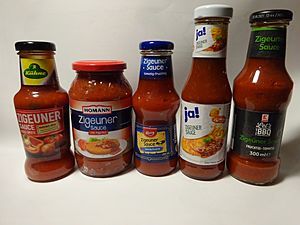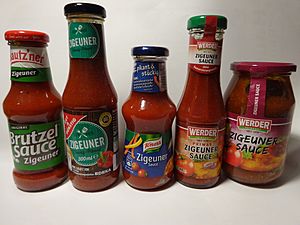À la zingara facts for kids

Gypsy sauces from Kühne, Homann, Kania, Ja!, and Kaufland brands
|
|
| Type | Condiment |
|---|---|
| Main ingredients | ham, tongue, mushrooms and truffles combined with tomato sauce, tarragon and sometimes madeira |
À la zingara is a special cooking term from French cuisine. It means "gypsy style" in French. This term describes a type of garnish or sauce. It's made from chopped ingredients like ham, beef tongue, mushrooms, and fancy truffles. These are mixed with a tomato sauce, tarragon, and sometimes Madeira wine.
Sometimes, other ingredients like white wine, cayenne pepper, lemon juice, or orange peel are added. The sauce is cooked until it gets thicker, which chefs call "reducing." This tasty garnish is often served with meats like veal or poultry. It can also be served with eggs.
Gypsy sauce (in German, Zigeunersauce) might have come from à la zingara. Gypsy sauce uses many of the same ingredients. Simpler versions, especially those you can buy in stores, often have fewer ingredients. They might use tomato paste, Hungarian paprika, bell peppers, and sometimes onion.
Contents
What is À la Zingara?
À la zingara has also been called singara or zingara sauce. However, some food experts see them as slightly different. For example, a book called Dictionary of Food lists them separately. It says à la zingara is "In the gypsy style, with ham, tongue, mushrooms and tomatoes." It describes zingara sauce as "A sauce for veal and poultry made to a variety of recipes and little used."
Old Recipes for À la Zingara
In 1869, a recipe for veal cutlets à la zingara used a sauce called espagnole sauce and ham. The espagnole sauce was cooked with the veal. Then, the fat was removed, and the sauce was strained through a sieve. Finally, it was served with the dish.
An older recipe from 1858 for veal cutlets à la zingara was similar. It added mushrooms and truffles around the veal and ham. After the meat was cooked, the espagnole sauce was made in the same pan. Lemon juice and cayenne pepper were added, and then the sauce was poured over the cutlets.
What is Gypsy Sauce?
Gypsy sauce is a type of sauce or demi-glace sauce. It can be used as an ingredient in dishes or as a condiment (like ketchup). The word "zigeuner" has been used in Germany for this sauce for over 100 years. Many companies make this sauce in large amounts, including Remia, Verstegen, and Unilever.
In 2013, there was some discussion about using the word "gypsy" on the labels of these sauces. There was also talk about its use in cafeterias in German public buildings.
Where the Name Comes From
The term Zigeuner has been used for this sauce in Germany for more than a century. This word was even used in a famous cookbook from 1903 called Le guide culinaire, written by Auguste Escoffier.
History of Gypsy Sauce
Gypsy sauce is a popular sauce used in Austrian, French, and German cuisine.
How Gypsy Sauce is Made
Today, gypsy sauce is usually made with tomato paste, Hungarian paprika, bell peppers, and sometimes onion. It can be made as a spicy sauce. Sometimes, whole or crushed canned tomatoes are used. Other ingredients can include onion, garlic, chicken broth, milk, and a sweetener like sugar or honey. Salt and pepper are also added for taste.
Another way to make the sauce is very similar to à la zingara. This version uses tomato slices or purée, onions, smoked tongue, ham, mushrooms, truffles, white wine or Madeira wine, butter, paprika, and pepper. The simpler version of gypsy sauce might have come from this more complex à la zingara sauce.
Making Gypsy Sauce for Stores
Many companies make gypsy sauce in large amounts to sell in stores. Some of these companies are Remia, Verstegen, and Unilever. Unilever sells it under their Knorr brand name.
How Gypsy Sauce is Used
Gypsy sauce is a key ingredient in a German dish called Zigeunerschnitzel. This is a type of schnitzel (a thin, fried piece of meat).
See Also


